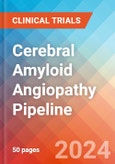Cerebral Amyloid Angiopathy Understanding
Cerebral Amyloid Angiopathy: Overview
Cerebral amyloid angiopathy (CAA) is a small vessel vasculopathy resulting from the pathologic deposition of amyloid-beta (Aβ) within the media and adventitia of cortical and leptomeningeal arteries, arterioles, capillaries and rarely the venules of the brain. The deposition of amyloid protein in these vessels is associated with fibrinoid necrosis, focal wall fragmentation, and micro aneurysms that predispose the patient to repeated episodes of blood vessel leakage and/or frank hemorrhage.Symptoms
The symptoms of Cerebral Amyloid Angiopathy include:
- Intracerebral hemorrhages
- Microinfarctions
- Leukoencephalopathy
Diagnosis
The Boston criteria are commonly used when evaluating patients for Cerebral amyloid angiopathy. It is a combination of clinical, pathological, and radiographic criteria that are used to assess the probability of Cerebral Amyloid Angiopathy. Definitive diagnoses can only be made through a postmortem examination of the brain. A “probable CAA” diagnosis can be made during life utilizing imaging or tissue sampling. Gradient-echo magnetic resonance imaging (MRI) is one of the most important techniques used for diagnosis. Gradient-echo magnetic resonance imaging (MRI) demonstrates regions of low-signal blooming artifact caused by iron depositions left by old hemorrhages.Treatment
Use of antihypertensive medications to prevent hemorrhage recurrence in Cerebral Amyloid Angiopathy. Immunosuppressants are used to treat rarer forms of CAA called CAA-related inflammation and β-amyloid-related angiitis. Use of antithrombotics, such as warfarin, can be associated with intracerebral hemorrhage risk in CAA.Cerebral Amyloid Angiopathy Emerging Drugs Chapters
This segment of the Cerebral Amyloid Angiopathy report encloses its detailed analysis of various drugs in different stages of clinical development, including phase II, I, preclinical and Discovery. It also helps to understand clinical trial details, expressive pharmacological action, agreements and collaborations, and the latest news and press releases.Cerebral Amyloid Angiopathy Emerging Drugs
Research programme: CNS disorders RNA interference -based therapeutics: Alnylam Pharmaceuticals
Alnylam Pharmaceuticals is developing research programme: CNS disorders RNA interference-based therapeutics which is in preclinical studies.Cerebral Amyloid Angiopathy: Therapeutic Assessment
This segment of the report provides insights about the different Cerebral Amyloid Angiopathy drugs segregated based on following parameters that define the scope of the report, such as:Major Players in Cerebral Amyloid Angiopathy
There are approx. 10+ key companies which are developing the therapies for Cerebral Amyloid Angiopathy. The companies which have their Cerebral Amyloid Angiopathy drug candidates in the most advanced stage, i.e. phase II include, Alnylam Pharmaceuticals.Phases
The report covers around 10+ products under different phases of clinical development like
- Late stage products (Phase III)
- Mid-stage products (Phase II)
- Early-stage product (Phase I) along with the details of
- Pre-clinical and Discovery stage candidates
- Discontinued & Inactive candidates
Route of Administration
Cerebral Amyloid Angiopathy pipeline report provides the therapeutic assessment of the pipeline drugs by the Route of Administration. Products have been categorized under various ROAs such as- Oral
- Parenteral
- intravitreal
- Subretinal
- Topical.
Molecule Type
Products have been categorized under various Molecule types such as
- Monoclonal Antibody
- Peptides
- Polymer
- Small molecule
- Gene therapy
Product Type
Drugs have been categorized under various product types like Mono, Combination and Mono/Combination.Cerebral Amyloid Angiopathy: Pipeline Development Activities
The report provides insights into different therapeutic candidates in phase II, I, preclinical and discovery stage. It also analyses Cerebral Amyloid Angiopathy therapeutic drugs key players involved in developing key drugs.Pipeline Development Activities
The report covers the detailed information of collaborations, acquisition and merger, licensing along with a thorough therapeutic assessment of emerging Cerebral Amyloid Angiopathy drugs.Report Highlights
The companies and academics are working to assess challenges and seek opportunities that could influence Cerebral Amyloid Angiopathy R&D. The therapies under development are focused on novel approaches to treat/improve Cerebral Amyloid Angiopathy.Cerebral Amyloid Angiopathy Report Insights
- Cerebral Amyloid Angiopathy Pipeline Analysis
- Therapeutic Assessment
- Unmet Needs
- Impact of Drugs
Cerebral Amyloid Angiopathy Disease Report Assessment
- Pipeline Product Profiles
- Therapeutic Assessment
- Pipeline Assessment
- Inactive drugs assessment
- Unmet Needs
Key Questions
Current Treatment Scenario and Emerging Therapies:
- How many companies are developing Cerebral Amyloid Angiopathy drugs?
- How many Cerebral Amyloid Angiopathy drugs are developed by each company?
- How many emerging drugs are in mid-stage, and late-stage of development for the treatment of Cerebral Amyloid Angiopathy?
- What are the key collaborations (Industry-Industry, Industry-Academia), Mergers and acquisitions, licensing activities related to the Cerebral Amyloid Angiopathy therapeutics?
- What are the recent trends, drug types and novel technologies developed to overcome the limitation of existing therapies?
- What are the clinical studies going on for Cerebral Amyloid Angiopathy and their status?
- What are the key designations that have been granted to the emerging drugs?
Key Players
Alnylam Pharmaceuticals
Key Products
- Research Programme: CNS disorders RNA interference-based therapeutics
This product will be delivered within 1-3 business days.
Table of Contents
Companies Mentioned (Partial List)
A selection of companies mentioned in this report includes, but is not limited to:
- Alnylam Pharmaceuticals








